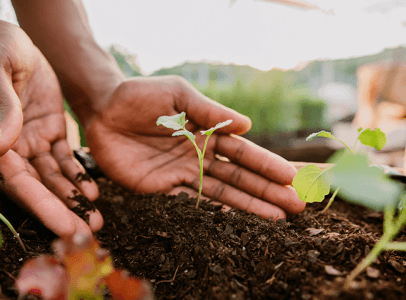Biodegradable vs. Compostable: What's the Difference?

Do biodegradable and compostable mean the same thing? The terms biodegradable and compostable are frequently used interchangeably. But they shouldn’t be. In this article, we’ll explain the meaning of each term and the role each one plays in supporting a healthy planet.
Biodegradable
It's important to reduce our carbon footprint by using biodegradable options whenever possible, such as biodegradable wet wipes and other items that will break down easier and faster.
What does biodegradable mean?
An item is biodegradable if it can be broken down into natural elements with the help of microorganisms, such as fungi and bacteria. Biodegradation is a naturally occurring process that can take anywhere from a few days to a few centuries. For a product to qualify as biodegradable, it must be able to break down naturally within a short time period after it is discarded — typically within one year.
What are common biodegradable materials?
Biodegradable materials can break down and return to nature. Some examples include:
- Bamboo
- Cotton
- Cork
- Wood
- Paper
- Egg shells
- Food waste
- Hemp
- Plant fibers
What are examples of biodegradable products?
Biodegradable materials can be used to make biodegradable products, such as personal hygiene items (biodegradable flushable wipes, toilet paper, and facial wipes). Hemp and cotton can be used to make clothing. Using biodegradable materials in products means after they are discarded and put into landfills, they will break down into natural materials over time and reduce the amount of waste left behind.
How long does it take biodegradable products to break down?
The length of time it takes for biodegradable items to decompose depends on the material and the environment. The amount of water, light, and oxygen all have an impact on how fast a material breaks down. Temperature can also make a difference during the biodegradation process.
Here’s a chart showing how long some common items take to biodegrade:
|
ITEM |
TIME TO BIODEGRADE |
|
Vegetables |
5 days – 1 month |
|
Paper |
2 – 5 months |
|
Cotton T-shirt |
6 months |
|
Orange peels |
6 months |
|
Tree leaves |
1 year |
|
Wool socks |
1 – 5 years |
|
Plastic-coated paper milk cartons |
5 years |
|
Tin cans |
50 – 100 years |
|
Aluminium cans |
80 – 100 years |
|
Styrofoam cups |
500+ years |
|
Plastic bags |
500+ years |
|
Glass bottles |
1 million years |
Source: Science Learning Hub
Compostable
Composting offers many environmental benefits, such as improving soil health and decreasing greenhouse gas emissions. It’s a natural process that recycles organic matter into fertilizer that is rich in nutrients.
What does compostable mean?
When something is compostable, that means it can be turned into a nutrient-dense soil, called humus, under specific conditions. Composting requires a balance of moisture, soil, temperature, and air, plus an external force (a human!) to turn the humus and aerate it. The humus can then be used as a fertilizer in your garden.
Composting can only happen via compost piles, compost bins, and compost facilities. Most people who compost have a compost pile at home. The majority of compostable items will break down under basic composting conditions at home. However, some items need more than a backyard compost pile to start the breakdown process. For example, bioplastic containers and utensils need to be composted at a facility. Compost facilities make sure the proper conditions are being used in order to compost items properly and efficiently.
What are common compostable materials?
If a material is compostable, then it is also biodegradable. However, not everything that is biodegradable is compostable.
Common compostable materials can be categorized as food vs. non-food or indoor vs. outdoor materials.
Compostable food materials:
- Fruit and vegetable scraps
- Herbs and spices
- Condiments
- Legumes
- Bread, cereal, crackers, rice, pasta
- Popcorn
- Plant-based milk
Compostable non-edible food materials:
- Tea leaves
- Coffee grounds
- Fruit pits and seeds
- Egg shells
- Popcorn kernels
Compostable indoor materials:
- Coffee filters (unbleached)
- Cardboard boxes, egg cartons, food containers, pizza boxes
- Wine corks
- Paper lunch bags
- Paper napkins and paper towels
- Paper cupcake liners
- Brown paper shopping bags
- Wooden chopsticks
- Bamboo skewers
- Wooden toothpicks
- Cotton balls
- Fingernail clippings
- Hair
- Cotton towels and sheets
- Paper (bills, junk mail, newspaper, non-glossy cards)
- Sticky notes
- Pencil shavings
Compostable outdoor materials:
- Leaves
- Grass, bush, shrub trimmings
- Flowers
- Weeds
- Hay and straw
- Sticks and twigs
- Wood chips
- Pine needles
- Pine cones
What are examples of compostable products?
There are many options when it comes to compostable products. Some restaurants use compostable takeout containers, plates, and cups. You can shower with compostable loofahs and clean your kitchen with compostable sponges. You can use compostable coffee pods and tea bags for your daily caffeine fix. Compostable products are everywhere and we can expect to see more as companies continue to innovate.
How long does it take compostable products to break down?
Similar to biodegradable items, compostable products break down at different rates depending on the method of composting and what the materials are.
Home compost piles are usually adequate when it comes to composting food scraps. Generally speaking, compostable items should break down within 12 weeks (approximately 3 months).
More complex items, such as compostable food containers, need to be composted in a certified compost facility. In these conditions, most items can be composted in about 6 months, while a home compost pile may take up to a year.
Biodegradable vs. Compostable: Which Is Better for the Environment?
In short, the primary difference between biodegradable and compostable is the condition each one requires in order to break down properly. One process requires human intervention (composting), while the other does not (biodegradation).
It may be confusing when shopping for biodegradable and compostable products, but understanding the main differences between the two terms can help you make more educated purchases. No matter which option you choose, know that you’re taking steps to help protect the planet when you purchase products that can break down faster instead of staying in landfills for decades to come.

References:
-
https://www.sciencelearn.org.nz/resources/1543-measuring-biodegradability
-
https://www.treehugger.com/biodegradable-compostable-difference-5094376
-
https://www.greenmatters.com/p/biodegradable-compostable-difference
-
https://www.sustainablejungle.com/zero-waste/biodegradable-vs-compostable/
-
https://www.sustainablejungle.com/zero-waste/what-is-compostable/
-
https://www.buzzfeed.com/melanie_aman/compostable-products-easy-swaps




